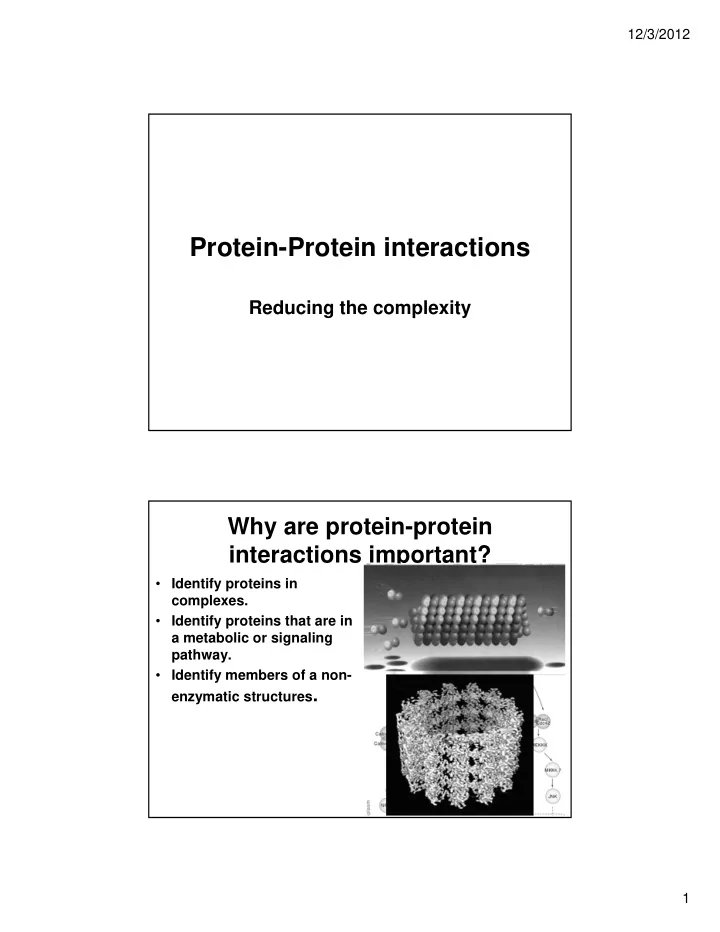

12/3/2012 Protein-Protein interactions Reducing the complexity Why are protein-protein interactions important? • Identify proteins in complexes. • Identify proteins that are in a metabolic or signaling pathway. • Identify members of a non- enzymatic structures . 1
12/3/2012 Protein complexes • Protein complexes can be made up of 2-50 identical or different proteins (subunits). • Some proteins in complexes may not have any apparent activity. • One protein subunit could have two activities, one not related to the complex function. Methods of studying protein- protein interactions . • Yeast two hybrid • Pull down or co-purification – (co-immunoprecipitation) • Fluorescence Resonance Energy Transfer (FRET) 2
12/3/2012 Yeast Two Hybrid Analysis • Need a way to identify if two proteins are near each other. • Many transcription promoters are composed of two domains which can be separated. – the binding domain – the activator domain • http://www.scq.ubc.ca/the-yeast-two-hybrid-assay-an-exercise-in-experimental- eloquence/ How Does it Work ? DNA 3
12/3/2012 How Does it Work? The process is usually performed with a single bait and it is probed with a genomic library of all the other proteins Cytosolic and Membrane Proteins Cub = c-terminal domain of ubiquitin binding protein NubG = n-terminal domain of ubiquitin binding protein TF = transcription factor Genome Res. 2003 13: 1744-1753 4
12/3/2012 Genomic scale screening • Use yeast mating types and put bait in one mating type and prey in the other. • Mixing methods – Mix one prey or bait with the whole genome with the other plasmid. – Mix batches of genomic bait and prey molecules. • Sequence plasmids from surviving colonies. Problems • Many false positive and negatives. • Fusion structure may affect protein interactions. • Proteins may not express well in yeast. • Transient interactions may be missed. • Rate of synthesis and degradation might be rapid. • Difficulty with multiple subunit proteins. 5
12/3/2012 Co-purification/ Immuno-trapping • Based on the principle that interacting proteins will stay together during purification. • Tag protein with antibody or affinity tag • Bind tag to column or plate. • Remove bound proteins and separate. • Sequence by LC/MS/MS. Affinity tags/columns – glutathione S-transferase – maltose binding protein • Binds to glutathione coupled • Binds to Maltose coupled column column • Removed with glutathione • Removed with maltose – hexyl histidine – FLAG • Binds to Ni+ chelating • Binds to FLAG antibody column column • Removed by addition of • Removed by denaturation imidazole – Strep II tag – calmodulin binding protein • Binds to Avidin coupled • Binds to calmodulin coupled column column • Can be removed with – protein A desthiobiotin • Binds to antibody column • Removed by denaturation 6
12/3/2012 Fluorescence Resonance Energy Transfer • When a fluorescent molecule is excited it will emit light as fluorescence. • If a second fluorescent molecule is present that absorbs in the wavelength range of the emission of the first fluorescent molecule it can absorb the light and emit the energy at a second wavelength. • Alternatively a second molecule can absorb the fluorescence and not emit the energy as light. This is called quenching. FRET • Processes is highly distance dependent, drops off by r -6 . – Efficiency of transfer = 1 - D+A / D 6 /(r 0 6 + r 6 ) – Efficiency of transfer = r 0 – Quantum Yield = D – r 0 represents the distance for 50% efficiency • The bait protein(s) is (are) tagged with one fluorescent molecule. • The prey protein(s) is (are) tagged with a complementary fluorescent molecule or quencher. • Look for change in fluorescence wavelength or quenching. Should occur only when two proteins are very close together (connected). 7
12/3/2012 Donor Acceptor Pairs Used in FRET Donor Acceptor Ro (Å) • Fluorescein Tetramethylrhodamine 55 • IAEDANS Fluorescein 46 • EDANS DABCYL 33 • Fluorescein QSY-7 dye 61 • BFP GFP 35 • CFP YFP 50 Ro is the distance at which the efficiency of energy transfer is 50% 8
Recommend
More recommend